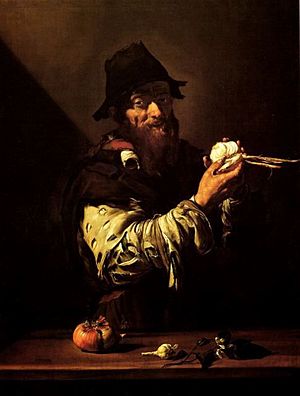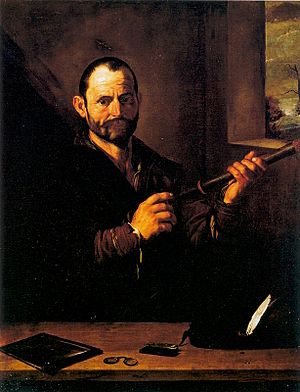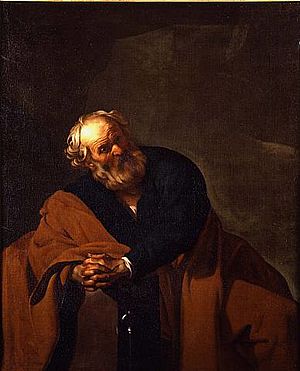Pietro Cussida facts for kids
Pietro Cussida (also known as Pietro Cuside or Pedro Cossida) was an important Spanish diplomat who lived a long time ago. He worked for two kings of Spain, Philip III of Spain and later his son, Philip IV.
Pietro Cussida was also a big fan of art. He collected many paintings and helped artists by giving them money and jobs. This is called being an art patron. He especially supported artists who painted in a style called Caravaggisti, like Jusepe de Ribera and Dirck van Baburen.
Who Was Pietro Cussida?
Pietro Cussida was originally from a city in Spain called Zaragoza. We know he was living in Rome by 1596. He was a regular customer at a bank there called Herrera & Costa.
Pietro Cussida had a wife named Giulia Martinez. They had two sons, Gianfrancesco and Luigi. Luigi later became a friar, which is a type of religious brother.
By 1602, Pietro Cussida was working as a diplomat for King Philip III of Spain. When Philip III died, Cussida continued to serve the new king, Philip IV. One of his important jobs was to find and buy artworks for the kings.
Pietro Cussida passed away in Rome in October 1622. He had collected a wonderful group of paintings. He left these paintings and his large house on the Via del Corso street to his son, Gianfrancesco. However, Gianfrancesco also died soon after, in August 1623.
Gianfrancesco's daughter, Laura Cussida, then inherited the art collection and the house. She was still a child at the time. Eventually, her guardian, Nicolò Gavotti, received the paintings and the family's grand house.
Pietro Cussida's Art Collection
Pietro Cussida was a very important supporter of artists. Because of his help, the artist Dirck van Baburen painted several artworks for a church in Rome called San Pietro in Montorio. These paintings included Entombment, Christ in the Garden of Gethsemane, and Christ on the Road to Calvary.
Van Baburen worked on this project around 1617 with another artist named David de Haen. It is now believed that David de Haen painted the curved parts (called lunettes) in the chapel. David de Haen even stayed at Cussida's house in 1621.
Between 1615 and 1616, Pietro Cussida also asked the artist Jusepe de Ribera to paint a special series of artworks. These paintings were allegories, which means they used symbols to represent the Five Senses (like sight, smell, touch, taste, and hearing). Ribera likely finished these paintings in Naples.
For a long time, some artworks were thought to be by an unknown artist called the "Master of the Judgement of Solomon." But in 1624, an inventory (a detailed list) of Gianfrancesco Cussida's belongings was found. This list helped experts realize that many of these paintings were actually created by Jusepe de Ribera.
See also
 In Spanish: Pedro Cosida para niños
In Spanish: Pedro Cosida para niños




